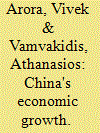|
|
|
Sort Order |
|
|
|
Items / Page
|
|
|
|
|
|
|
| Srl | Item |
| 1 |
ID:
107997


|
|
|
|
|
| Publication |
2011.
|
| Summary/Abstract |
China's economic development since 1978 is one of the most significant events in recent history. Many aspects of this development have been extensively analyzed in the published literature. However, the implications of China's growth for other countries have been relatively neglected. The present paper attempts to fill this gap in the literature. The paper first presents some facts on China's role in the world economy, and then measures the impact of China's growth on growth in the rest of the world in both the short term and the long term. Short-run estimates based on vector autoregression and error correction models suggest that spillover effects of China's growth have increased in recent decades. Long-term spillover effects, estimated through growth regressions based on panel data, are also significant and have extended in recent decades beyond Asia. The estimates are robust to the effects of global and regional shocks, changes in model specification, and sample period.
|
|
|
|
|
|
|
|
|
|
|
|
|
|
|
|
| 2 |
ID:
191371


|
|
|
|
|
| Summary/Abstract |
Greener alternatives for fuelling automobiles, such as hydrogen transport and electric vehicles, have shown considerable promise in transportation. Many others are sceptical of the growing enthusiasm for these new technologies, believing that energy storage technologies and management are insufficient for a complete shift. Such a network of variables and smart grid technologies that can help with the transition may reveal some systemic hazards linked with financial institutions, company risk and failure, and so on. This study attempts to characterise spillovers and connections between the indices of green transportation, smart grid, innovative materials, energy storage, and energy management globally. To do this, we employ a novel strategy developed by Balcilar et al. (2021) as well as a robustness check using the well-known Diebold and Yilmaz (2012) method. The study highlights the sub-systemic sector's connections, giving policymakers insights into instruments to support financial market sustainability and stability. It would be critical to separate the impact of these indicators, but given the intrinsic relationship, this would be nearly impossible. The transportation innovation network is not rigid and established in its interconnection. The role of indicators shifts from transmitting to absorbing shocks regularly, and policymakers who want to encourage long-term solutions must be aware of this.
|
|
|
|
|
|
|
|
|
|
|
|
|
|
|
|
| 3 |
ID:
192766


|
|
|
|
|
| Summary/Abstract |
Greener alternatives for fuelling automobiles, such as hydrogen transport and electric vehicles, have shown considerable promise in transportation. Many others are sceptical of the growing enthusiasm for these new technologies, believing that energy storage technologies and management are insufficient for a complete shift. Such a network of variables and smart grid technologies that can help with the transition may reveal some systemic hazards linked with financial institutions, company risk and failure, and so on. This study attempts to characterise spillovers and connections between the indices of green transportation, smart grid, innovative materials, energy storage, and energy management globally. To do this, we employ a novel strategy developed by Balcilar et al. (2021) as well as a robustness check using the well-known Diebold and Yilmaz (2012) method. The study highlights the sub-systemic sector's connections, giving policymakers insights into instruments to support financial market sustainability and stability. It would be critical to separate the impact of these indicators, but given the intrinsic relationship, this would be nearly impossible. The transportation innovation network is not rigid and established in its interconnection. The role of indicators shifts from transmitting to absorbing shocks regularly, and policymakers who want to encourage long-term solutions must be aware of this.
|
|
|
|
|
|
|
|
|
|
|
|
|
|
|
|
| 4 |
ID:
092535


|
|
|
|
|
| Publication |
2009.
|
| Summary/Abstract |
Using a large panel dataset covering all manufacturing firms (above a minimum scale) in China from 1998 to 2005, this paper examines whether there exist productivity spillovers from foreign direct investment (FDI) to domestic firms. In estimating productivity, we control for a possible simultaneity bias by using semi-parametric estimation techniques. We find that Hong Kong, Macao and Taiwan (HMT) invested firms generate negative horizontal spillovers, while Non-HMT foreign invested firms (mostly from OECD countries) tend to bring positive horizontal spillovers in China. These two opposing horizontal effects seem to cancel out at the aggregate level. We also find strong and robust vertical spillover effects on both state-owned firms and non-state firms. However, vertical spillover effects from export-oriented FDI are weaker than those from domestic-market-oriented FDI.
|
|
|
|
|
|
|
|
|
|
|
|
|
|
|
|
| 5 |
ID:
192055


|
|
|
|
|
| Summary/Abstract |
In this paper, we study closely the relationship between arms exports, labor productivity and economic growth. Using a connectedness-measurement technology fundamentally grounded in modern network theory, we determine the size and direction of the spillover effects between these three variables. Our findings indicate that shocks from arms exports have direct spillovers over the labor productivity and GDP growth, whereas the reverse is not captured by our data. We also provide a dynamic analysis of the spillovers that confirm the direction of spillovers from arms exports to the other variables. The recent evolution of arms exports from the United States together with the changes in arms exports policy show the timeliness of studying the effects of this particular trade to the rest of the economy.
|
|
|
|
|
|
|
|
|
|
|
|
|
|
|
|
| 6 |
ID:
177827


|
|
|
|
|
| Summary/Abstract |
This article assesses the spillover effects between terrorist activity and Spanish stock market returns for the period 1993–2017 . We construct a daily terror index that reflects the terrorist activity of different types of perpetrators: domestic terrorism (ETA) and international terrorism linked to Islamic extremism. Our static analysis shows that connectedness is important, as it explains about half of the forecast error variance; most of it is attributed to shocks from terrorist events on stock market return forecasts. Our dynamic analysis also uncovers an increase in spillover effects between the early period characterised by ETA terrorist attacks and the recent past characterised by Islamic terrorist attacks.
|
|
|
|
|
|
|
|
|
|
|
|
|
|
|
|
| 7 |
ID:
111335


|
|
|
|
|
| Publication |
2012.
|
| Summary/Abstract |
This paper is focused on the analysis of spillover benefits of the ongoing R&D programme on thermonuclear fusion technology. The spillover effects are understood here as positive externalities of publicly funded R&D, demonstration and deployment (RDDD) activities that may be revealed at the companies' level in the form of newly created knowledge stock; development of innovative products/processes with broader market applications; strengthening of R&D, manufacturing and marketing capabilities; etc. An integrated compound real options model is proposed that allows to estimate the strategic net social present value of fusion RDDD programme taking into account the different types of spillover benefits along with the hidden real options value arising due to uncertainty and managerial flexibility. It was found that the value of spillover effects, modelled as "expansion option", could represent a significant proportion of the overall socio-economic value of fusion RDDD programme (nearly 20%). This paper clearly demonstrates that, besides a high-level mission to assure sustainable energy supply, fusion RDDD programme may yield substantial net socio-economic benefits that may be at least two times higher compared to the expected RD&D costs, and hence the pursuit of even more ambitious programme is economically justified.
|
|
|
|
|
|
|
|
|
|
|
|
|
|
|
|
| 8 |
ID:
102714


|
|
|
| 9 |
ID:
141178


|
|
|
|
|
| Summary/Abstract |
Using the Cobb–Douglas production function and vertical specialization share, the present paper measures the productivity spillover effects of offshore outsourcing in the Chinese manufacturing industry. We examine different production factors and the degree of openness by dividing the Chinese manufacturing industry into five major categories: capital-intensive business, technological-intensive business, labor-intensive business, open business and non-open business. The results show that offshore outsourcing is positively associated with productivity in the Chinese manufacturing industry as a whole, but less so in labor-intensive industries and more in capital-intensive industries. Moreover, the positive impact of outsourcing on productivity is slightly higher in open industries than in non-open industries. These results shed light on the differential spillover effects of offshore outsourcing on productivity. Our findings suggest that outsourcing structure is important to China's long-run competitive advantage. China's policy-makers should encourage further offshore capital-intensive and technology-intensive activities and focus more on outward-oriented offshore businesses.
|
|
|
|
|
|
|
|
|
|
|
|
|
|
|
|
| 10 |
ID:
176879


|
|
|
|
|
| Summary/Abstract |
This paper examines the spatial spillovers of pollution onto the underground economy. The extant literature has considered the pollution-informal economy nexus to some extent, but the spillover effects across national borders have been ignored. Pollution can increase the underground sector when some formal sector production moves to the informal sector (“scale effect”), whereas greater pollution can reduce the underground sector when it invites tougher regulations (“substitution effect”). Results, based on a panel of more than 130 nations and allowing for reverse causality, show both own- and border pollution reduce the underground sector - consistent with the substitution effect. In other results, we find opposite effects of economic and political freedom, and some differences in the influences of specific dimensions of economic freedom and the role of the government. Further, we find that while the size of government increases the underground sector, better institutional quality reduces it. Policy implications of these findings are discussed. The spillovers from neighboring nations are especially relevant for nations that are not islands, which is true for a majority of countries around the world.
|
|
|
|
|
|
|
|
|
|
|
|
|
|
|
|
| 11 |
ID:
143432


|
|
|
|
|
| Summary/Abstract |
The present study uses firm survey data of 1033 manufacturing firms operating in Ethiopia in 2011 to examine the impact of Chinese outbound direct investment on the productivity of domestic firms. Particularly, we attempt to answer two questions. Firstly, are Chinese-owned (henceforth foreign) firms more productive than local ones? Secondly, does the presence of foreign firms generate technology spillovers on domestic firms operating in the same industry? Our empirical results show that foreign firms are more productive and that their presence has different spillover effects on the productivity of domestic firms. In particular, we find that domestic firms with higher absorptive capacity experience positive spillovers, while those with low absorptive capacity witness negative spillover. We also find that small firms and non-exporting firms benefit more from spillovers than do other types of domestic firms. In this study, instrumental variables are used to address the potential endogeneity between foreign firm presence and domestic firm productivity.
|
|
|
|
|
|
|
|
|
|
|
|
|
|
|
|
| 12 |
ID:
192759


|
|
|
|
|
| Summary/Abstract |
The most recent dramatic increases in European Gas and Electricity prices demonstrate how vulnerable Europe is to energy supply shocks. We investigate the transmission of shocks from natural gas prices to local electricity prices in 21 European electricity markets. Using a quantile connectedness model, we find that the vulnerability of electricity markets in Europe varies both over time and across quantiles. Natural gas price shocks have a significant and nearly symmetrical impact on extreme quantiles of electricity prices. However, for moderate price changes, there is a disconnection between electricity and natural gas markets. We also identify the European countries that are most and least vulnerable to shocks in natural gas prices, which is due to differing energy mixes for electricity production. This novel vulnerability index has implications for the development of country-specific regulations and energy policies aimed at reducing the reliance on natural gas in European economies, combating energy poverty, and promoting the growth of renewable energy sources.
|
|
|
|
|
|
|
|
|
|
|
|
|
|
|
|
|
|
|
|
|